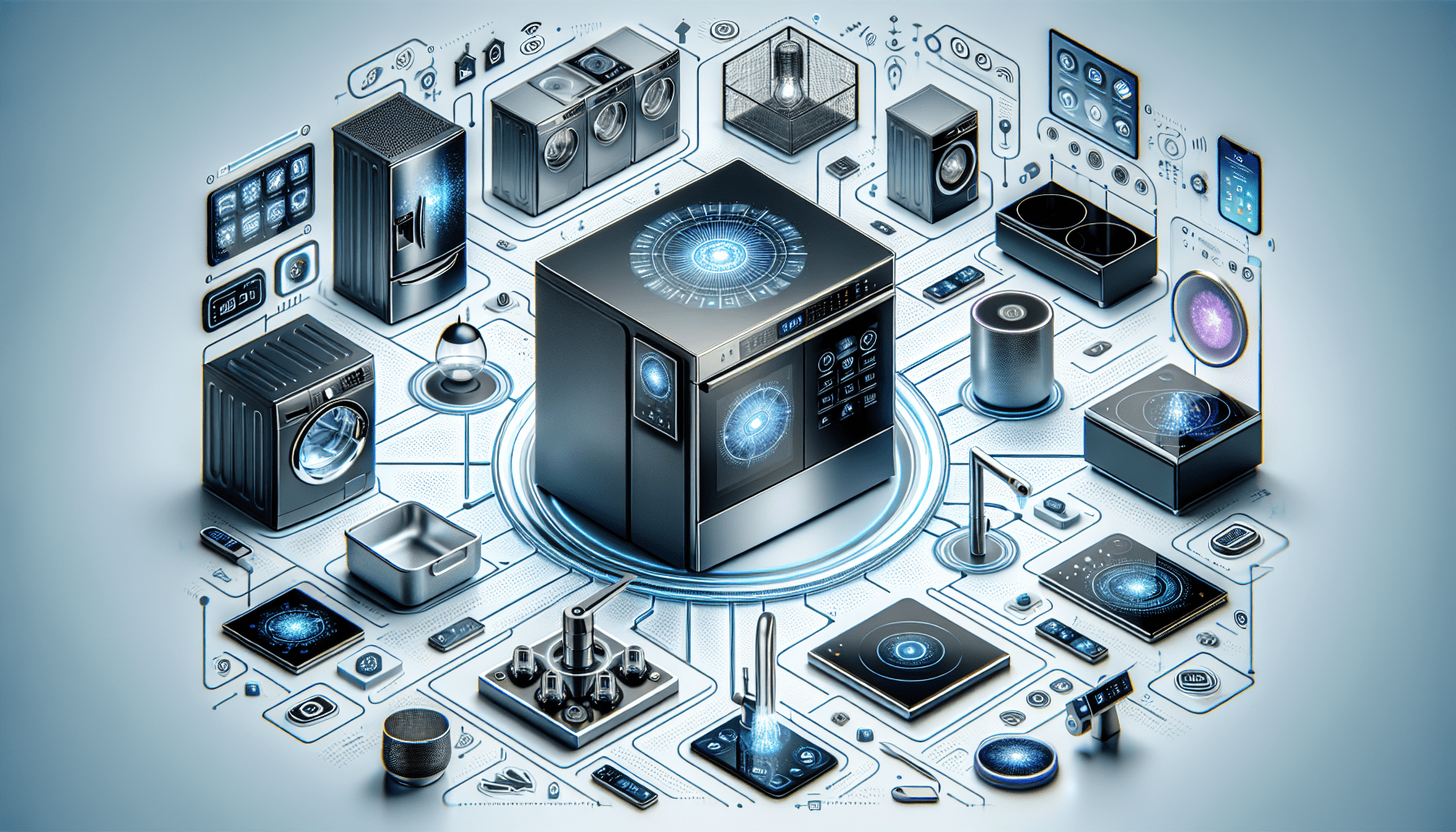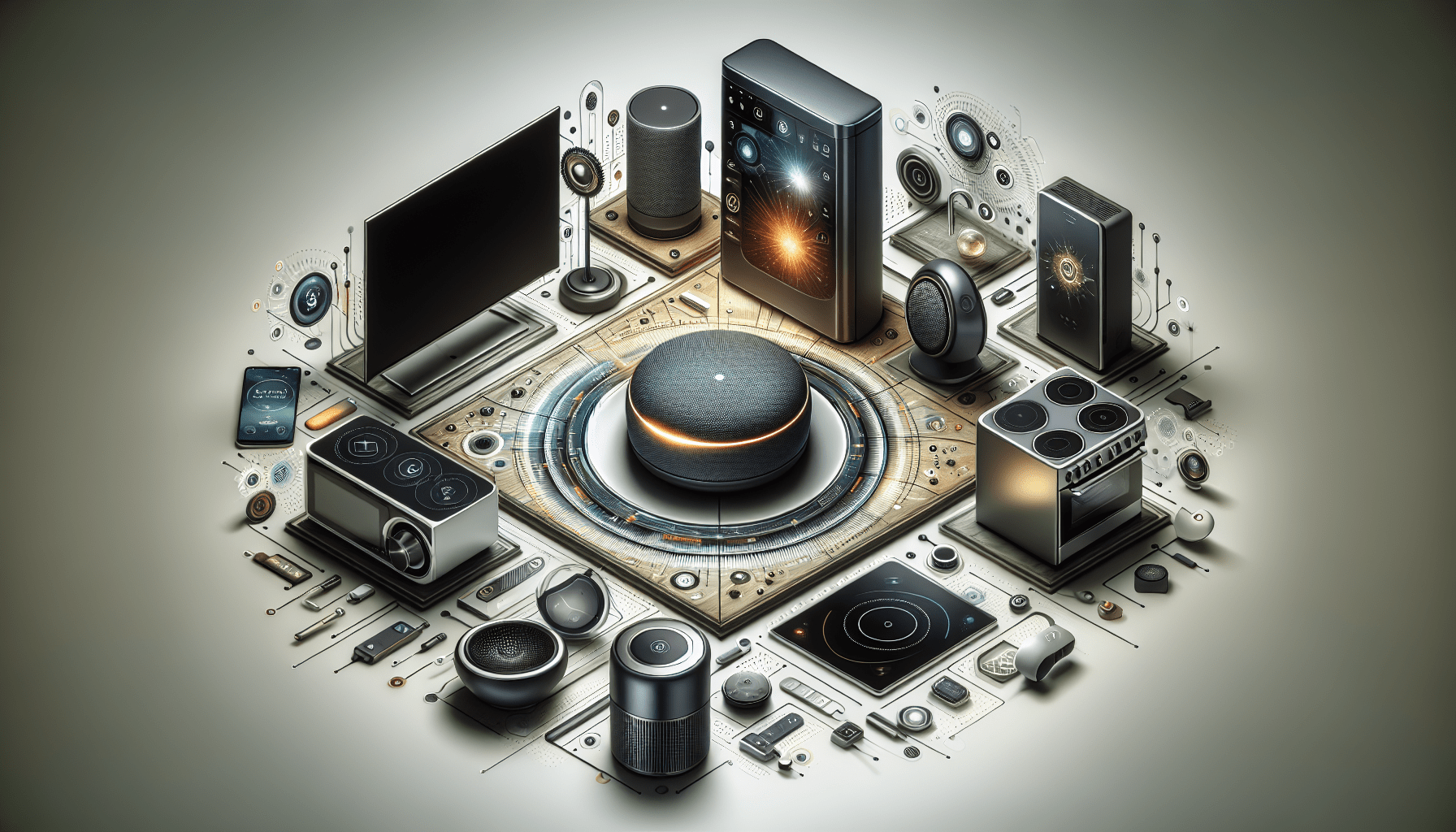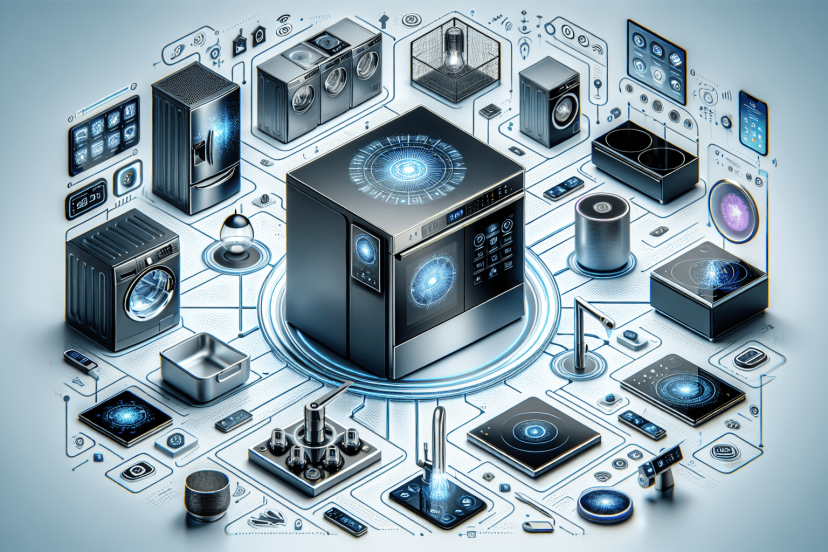How Does A Smart Home Appliance Work?
Imagine a world where your home knows your every need and desire, seamlessly adjusting to create the perfect environment for you. From turning on the lights as you walk in, to brewing your morning coffee just the way you like it, smart home appliances are revolutionizing the way we live. But have you ever wondered how these devices actually work? In this article, we will explore the fascinating inner workings of smart home appliances and discover how they are able to anticipate and respond to our every command, making our lives easier and more convenient than ever before.

Overview of Smart Home Appliances
Smart home appliances are revolutionizing the way we interact with and control everyday devices in our homes. They are part of the broader concept of a smart home, which refers to the integration of various technologies to enhance our living spaces. A smart home appliance is specifically designed to connect to other devices and systems in your home, allowing for remote control, automation, and advanced features.
Definition of a Smart Home Appliance
A smart home appliance is a device that incorporates advanced technology and connectivity to provide enhanced functionality and convenience. These appliances can be controlled and monitored remotely through a centralized hub or your smartphone, allowing you to manage and customize settings from anywhere. The main characteristics of a smart home appliance include connectivity, automation, and the ability to gather and analyze data.
Common Types of Smart Home Appliances
There is a wide range of smart home appliances available on the market today, catering to various needs and preferences. Some of the most common types include smart thermostats, smart lighting systems, smart security cameras, smart locks, smart kitchen appliances (such as refrigerators and ovens), and smart entertainment systems. Each of these appliances offers unique features and benefits that enhance convenience, energy efficiency, and home security.
Benefits of Smart Home Appliances
The adoption of smart home appliances brings numerous benefits to homeowners. Firstly, these appliances offer improved convenience by allowing you to control and monitor them remotely. For example, you can turn on your thermostat before arriving home, ensuring a comfortable temperature upon your arrival. Secondly, smart home appliances can contribute to energy savings through features like automation and energy monitoring. By optimizing energy consumption, you can reduce your carbon footprint and lower utility costs. Lastly, these appliances can enhance home security by providing real-time monitoring and alerts, giving you peace of mind when you’re away from home.
Key Components of a Smart Home Appliance
Smart home appliances are made up of several key components that work together to provide their advanced features and functionality.
Sensors and Detectors
Sensors and detectors are crucial components of smart home appliances. They enable the appliances to gather data from their surroundings and provide accurate information for automation and control. Examples of commonly used sensors include temperature sensors, motion sensors, humidity sensors, and light sensors. These sensors detect changes in their environment and trigger actions based on predetermined settings.
Connectivity Features
Connectivity is a fundamental aspect of smart home appliances. These appliances are designed to connect to your home’s Wi-Fi network, enabling seamless communication with other devices and the central controller. By establishing a stable and secure connection, smart home appliances can receive commands and transmit data, allowing for control and monitoring from your smartphone or hub.
Microcontrollers and Processors
Microcontrollers and processors are the “brains” of smart home appliances. They are responsible for executing commands, processing data, and controlling various functions of the appliance. These components enable the appliance to interpret user inputs, perform calculations, and interact with other devices in your smart home network. The power and capability of the microcontroller or processor determine the overall performance of the appliance.
User Interface
The user interface is the means through which you interact with the smart home appliance. It can take the form of physical buttons, touchscreens, or voice command capabilities. The user interface allows you to set preferences, adjust settings, and access advanced features. A well-designed user interface ensures a smooth and intuitive user experience, making it easy for you to customize and control your smart home appliances.
Communication Protocols
Communication protocols are essential for facilitating communication between smart home appliances and other devices or platforms.
Wireless Communication Protocols
Wireless communication protocols are the backbone of smart home automation. They enable appliances to connect and communicate with other devices wirelessly, eliminating the need for physical connections. Some of the most widely used wireless communication protocols in smart home appliances include Zigbee, Z-Wave, Thread, Wi-Fi, and Bluetooth. Each protocol has its own strengths and limitations, and the choice of protocol depends on the specific requirements of the appliance and the desired level of interoperability.
Zigbee
Zigbee is a wireless communication protocol specifically designed for low-power devices in home automation. It operates on the IEEE 802.15.4 standard and provides reliable and secure communication between devices. Zigbee allows for long battery life, making it suitable for devices like smart sensors and smart lighting systems. It offers a mesh network topology, enabling devices to communicate with each other and extend the range of the network.
Z-Wave
Z-Wave is another popular wireless communication protocol used in smart home appliances. It operates on the sub-GHz frequency range and offers a mesh network topology similar to Zigbee. Z-Wave is known for its interoperability, allowing devices from different manufacturers to work together seamlessly. It provides a reliable and stable connection, making it suitable for devices that require real-time responsiveness, such as smart locks and security systems.
Thread
Thread is a relatively new wireless communication protocol that is gaining traction in the smart home industry. It is designed to provide reliable and secure communication for low-power devices, particularly those utilizing IPv6. Thread offers a mesh network topology and supports seamless integration with IP-based devices and platforms, making it ideal for smart home appliances that require internet connectivity and interoperability.
Wi-Fi
Wi-Fi is a ubiquitous wireless communication protocol found in almost every household. It offers high-speed connectivity and is commonly used for devices such as smartphones, tablets, and laptops. Many smart home appliances have Wi-Fi capabilities, allowing them to connect to your home network and the internet. Wi-Fi provides a wide coverage range, making it suitable for appliances that require remote control and access.
Bluetooth
Bluetooth is a short-range wireless communication protocol widely used for connecting devices such as smartphones, headphones, and speakers. It is known for its energy efficiency and ease of use. Bluetooth is commonly used in smart home appliances that require direct connectivity to a smartphone or a hub. While its range is limited compared to other protocols, it is suitable for devices that don’t require long-distance communication.

Smart Home Hub or Central Controller
A smart home hub, also known as a central controller, is a device that serves as the central command center for all your smart home appliances and devices. It acts as a bridge between your appliances and your smartphone or other control devices. The main functions and roles of a smart home hub include:
Function and Role of a Smart Home Hub
A smart home hub provides a centralized interface for managing and controlling all your smart home appliances. It acts as a translator, allowing you to communicate with your appliances through a single device or app. The hub aggregates data from various sensors and devices, enabling you to monitor and control multiple appliances simultaneously. It also provides the necessary infrastructure for automation, scheduling, and integration with other smart devices and platforms.
Integration with Various Smart Devices
A smart home hub is designed to integrate with a wide range of smart devices and appliances. It supports different communication protocols, allowing you to connect devices from various manufacturers and ensure interoperability. By centralizing control and management, the hub simplifies the user experience and eliminates the need for separate apps or controllers for each device. This integration enables you to create customized scenes, automate routines, and control multiple devices with a single command.
Voice-Activated Control
Many smart home hubs support voice-activated control through integration with virtual assistants like Amazon Alexa or Google Assistant. This feature allows you to control your smart home appliances using voice commands, making it even more convenient and hands-free. With a simple voice command, you can turn on or off lights, adjust thermostat settings, play music, and perform various tasks without needing to physically interact with the hub or your smartphone.
Automation and Programming
One of the key advantages of smart home appliances is their ability to automate tasks and routines, freeing up your time and enhancing convenience.
Automated Tasks and Routines
Smart home appliances can be programmed to perform specific tasks automatically based on predefined triggers or schedules. For example, you can set your smart lights to turn on gradually in the morning to simulate a natural sunrise, or program your smart thermostat to adjust the temperature according to your daily routine. These automated tasks eliminate the need for manual intervention and ensure that your appliances adapt to your preferences and lifestyle.
Scheduling and Timers
Scheduling and timers are essential features of smart home appliances that allow you to control their behavior based on specific time intervals. You can set timers to turn off lights after a certain period or schedule your smart thermostat to increase the temperature before you wake up or return home. By using scheduling and timers, you can optimize the energy efficiency of your appliances and reduce unnecessary usage.
Integration with Virtual Assistants
Smart home appliances can be integrated with popular virtual assistants like Amazon Alexa, Google Assistant, or Apple Siri. This integration enables voice control and interaction with your appliances, making it more intuitive and user-friendly. You can give voice commands to perform specific actions or ask for information, such as turning on the coffee maker or checking the status of your smart security system. Integration with virtual assistants adds another layer of convenience and enhances the natural interaction with your smart home appliances.
Data Collection and Analysis
Smart home appliances are capable of gathering and analyzing data from various sources to provide insights, automation, and personalized experiences.
Data Gathering from Sensors and Other Sources
Smart home appliances collect data from built-in sensors, external sensors, and other sources in your home. For example, a smart thermostat collects data on temperature, humidity, and occupancy to optimize energy usage. Smart security cameras gather data on motion detection and video feeds for surveillance and monitoring purposes. The data collected from these sources is used to inform decision-making and enable automation.
Cloud-Based Storage
Data collected by smart home appliances is often stored in the cloud. Cloud-based storage allows for easy access, synchronization, and sharing of data across multiple devices. It also provides a secure and reliable storage solution, ensuring that your data is backed up and protected. Cloud storage enables seamless integration with other smart home devices and platforms, allowing you to analyze and visualize data to gain insights into your energy usage, security, and overall home environment.
Machine Learning and Artificial Intelligence
Advanced smart home appliances leverage machine learning and artificial intelligence algorithms to analyze data and make intelligent decisions. These algorithms can learn your preferences, patterns, and behaviors over time, allowing appliances to adapt and automate tasks accordingly. For example, a smart lighting system can learn your lighting preferences based on your past usage and adjust the lighting accordingly. Machine learning and AI also enable predictive capabilities, such as recommending energy-saving settings or alerting you to unusual events or anomalies.
Smart Home Appliance Security
With the increasing connectivity and data exchange in smart home appliances, security is a significant concern. Manufacturers implement various measures to ensure the security and privacy of your data and protect against unauthorized access.
Encryption and Authentication
Smart home appliances use encryption techniques to secure data transmissions. Encryption ensures that data is encoded and can only be deciphered by authorized devices or users. Additionally, authentication mechanisms, such as passwords or biometrics, are implemented to validate the identity of users or devices trying to access the appliance. These security measures minimize the risk of data breaches and protect your privacy.
Firewall and Intrusion Detection Systems
Many smart home appliances incorporate built-in firewalls and intrusion detection systems to safeguard against external threats. Firewalls monitor and regulate incoming and outgoing network traffic, blocking unauthorized access and potential threats. Intrusion detection systems analyze network activity and identify any suspicious behavior or anomalies. These security measures ensure that your smart home appliances are protected from malicious attacks and unauthorized access attempts.
Firmware Updates
Firmware updates are crucial for maintaining the security of smart home appliances. Manufacturers regularly release updates to address security vulnerabilities or add new features. It is essential to keep your devices up to date by installing firmware updates as they become available. These updates patch any potential security loopholes and ensure that your smart home appliances remain secure against emerging threats.
Energy Management
Smart home appliances play a significant role in energy management and conservation, helping you reduce your environmental footprint and save on energy bills.
Energy Monitoring and Consumption Analysis
Smart home appliances equipped with energy monitoring capabilities allow you to track and analyze your energy consumption patterns. For instance, a smart meter can provide real-time data on your electricity usage, while a smart plug can measure the energy consumed by individual devices. By monitoring and analyzing this data, you can identify areas of high energy consumption and make informed decisions to minimize wastage and optimize energy usage.
Smart Thermostats and Lighting
Smart thermostats and lighting systems are key components of energy management in smart homes. Smart thermostats enable intelligent temperature control, adapting to your preferences and occupancy patterns to optimize energy usage. They can automatically adjust the temperature when you’re away or asleep, reducing unnecessary heating or cooling. Similarly, smart lighting systems offer features such as dimming, scheduling, and occupancy detection to reduce energy waste by ensuring lights are only on when needed.
Energy Saving Recommendations
Smart home appliances can provide energy-saving recommendations based on the data collected and analyzed. For example, a smart energy monitor might suggest adjusting your thermostat settings or using energy-efficient appliances. These recommendations can help you make informed choices and adopt energy-saving practices, ultimately helping you reduce your carbon footprint and save on utility bills.
Integration with Mobile Devices
Smart home appliances seamlessly integrate with mobile devices, allowing for easy control, monitoring, and access to advanced features.
Smartphone Apps and Control
Most smart home appliances come with dedicated smartphone apps that provide a user-friendly interface for controlling and monitoring your devices. These apps allow you to access your appliances remotely, adjust settings, create custom routines, and receive alerts or notifications. With the convenience of the smartphone app, you can manage your smart home appliances anytime, anywhere, as long as you have an internet connection.
Remote Access and Monitoring
The integration with mobile devices enables remote access and monitoring of smart home appliances. With a smartphone or tablet, you can remotely control and monitor your appliances, even when you’re away from home. For example, you can check the status of your security cameras, lock or unlock doors, or receive alerts about unusual activities. Remote access and monitoring provide peace of mind and ensure that you stay connected to your home and appliances no matter where you are.
Compatibility with iOS and Android
Smart home appliances are designed to be compatible with both iOS and Android devices, ensuring broad compatibility and accessibility to a wide range of users. Whether you own an iPhone or an Android smartphone, you can easily find and download the corresponding app for your smart home appliances. This compatibility promotes inclusivity and allows users to fully enjoy the benefits of smart home technology regardless of their choice of mobile device.
Challenges and Considerations
While smart home appliances offer numerous benefits and convenience, there are also potential challenges and considerations to keep in mind.
Interoperability Issues
Interoperability remains a major challenge in the smart home industry. With various communication protocols and standards, it can be challenging to ensure seamless integration among devices from different manufacturers. Incompatibility issues can arise, leading to a fragmented user experience and limited functionality. It is essential to research and choose devices that support common standards to prevent compatibility issues.
Privacy and Data Protection
The increased connectivity and data exchange in smart home appliances raise concerns about privacy and data protection. Appliances may collect sensitive data about your daily routines, occupancy, and energy consumption. It is crucial to review the privacy policies and data handling practices of manufacturers to ensure that your data is collected and stored securely. Additionally, taking measures such as enabling strong passwords and keeping firmware up to date can help protect against unauthorized access.
Reliability and Dependence on Internet Connection
Smart home appliances heavily rely on a stable and reliable internet connection for proper functionality. If your internet connection goes down or becomes unstable, it may affect the performance of your smart appliances. This reliance on the internet can pose challenges, especially in areas with poor connectivity or during network outages. It is important to consider these factors and have backup plans or alternative control methods in place to mitigate disruptions in functionality.
In conclusion, smart home appliances are changing the way we interact with our homes, offering enhanced convenience, energy efficiency, and security. They incorporate advanced technology, connectivity, and automation to provide intuitive control and personalized experiences. By understanding the key components, communication protocols, and functions of smart home appliances, you can make informed decisions when integrating them into your home. While challenges and considerations exist, the benefits of smart home appliances make them a worthwhile investment for modern homeowners.




